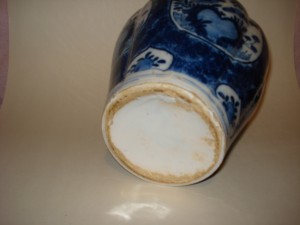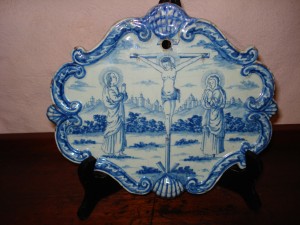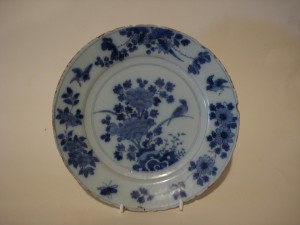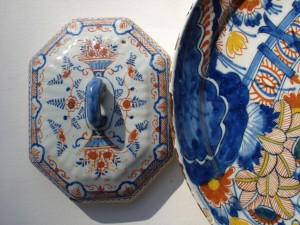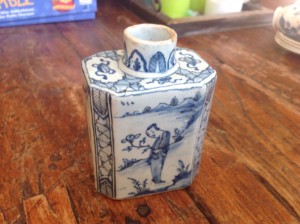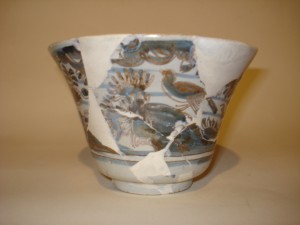Gedeelde publieksvoorwerpen
Laatste reacties
Thank you Roger for your comment
I agree with your conclusion. I
just was not sure
I think your plate is earlier then 1760, a date of 1720's appears more likely
Most likely it was made at the Drie Posteleyne Astonne under the ownership of
Zacharias Dextra (1721-1759). I have a dinner plate with the same design and mark and its
form is typically 1720's .
I believe that both Z Dextra and Jan T Dextra ( Zacharias'nephew) signed their work with a D.
Dear Suzanne
Thank you for your advise. I agree that it is very difficult to attribute pieces of unmarked Delftware.
Roger, thank you for your reaction which gives another clue that the plate might have been produced at De Maatale Pot. I find the way the chrysanthemums are painted to be very indicative of a Metaale Pot attribution.
Regards Jan
Dear Jeroen
Thank you for your reaction.
I agree with you, as far as I can be sure, this box is genuine.
It is interesting that most IVL pieces turn up in France these days.
For a long time I considered them to be fake imitations as well, particularly because few
of the early Delft collections contain IVL marked pieces. Also because many dealers advertised
these pieces as late 17th century which they certainly were not.
After purchasing a few pieces I changed my mind and I think that most of the IVL
pieces that I have seen were Dutch Delft made for the French market and date from the 1730s.
This link with the French market is interesting as early (circa 1700) pieces of Metaale Pot and Grieksche A
Delftware now turn up in the French market.
De Klaauwe, De Metale Pot and De Grieksche A must have been very active in exporting their wares to France
in the 1690-1720 time period
Regards Jan
Dear Jeroen I have added more photos
The red colour does sit proud and can be felt, but I do not think it is petit fue it feels and looks like the normal
red found on Dutch grand fue decorated Delftware.
The yellow lies below the red and is thick and can be felt but again I think it is a grand fue colour and not enamel.
I have listed a similar caddy to yours
You might be interested to have a look
Jan van Zijl
Dear Edwin
Thank you for your reaction
To my knowledge 'Paarse trek' was achieved by mixing Cobalt with Iron Oxide OR it was achieved by painting in Manganese Oxide. Usually the blue cobalt decorative pattern was merely outlined. Painting in blocks of Manganese purple was not really common until 1680.
The interesting thing about this bowl is that the red/brown decoration is not just used to outline a cobalt blue design but is used to paint in whole blocks of colour. The red area when analysed by X-ray spectography shows the existence of iron haematite mineral ONLY. There is no cobalt present in these red areas.
It would suggest that a red clay was used to paint in the red/brown design elements
Dear Marco
I agree that the vase is not a genuine 1710 Greek A example, It is a 19thC French copy.
I disagree however with the comments about the red decoration. Yes, red enamelling
was carried out at the Greek A (petit fue decoration) however your vase is decorated in
grand fue colours. Around 1690 the decorators in Delft are said to have discovered the secret
of applying the colour red that could survive the high temperature second firing of 1100 C.
Although the red looks like it is on the surface, it is not a later applied enamel fixed in a third firing.
I believe that the red grand fue colour was achieved by using a red, bole clay rather than a metallic oxide
and therefore it often appears to sit proud on the surface. On genuine pieces of 18thC Delft this red
grand fue colour has inevitably burnt through to the tin glaze in many places.
Personally I believe that experiments to make a grand fue red were already in place in the 1650's and I will submit
evidence of my view on a separate post
Dear Susan
I have to respectfully disagree with your conclusion
I have examined this box closely and I am sure it a genuine 18thC piece.
The cobalt blue colour is identical to the blue found on other IVL marked pieces I have in my collection and I have included another photo to illustrate the similarity.
I agree with you that the decoration is atypical for Dutch Delftware and owns many of its design elements to French Rouen wares. I believe that this is the case because it was made for the French market and was made to compete with the wares being produced in Rouen and Nevers.
For me the definitive proof is in the red decoration which is not of the even 19th C type but has the coarse burnt appearance which you find on genuine 18th C Dutch Delftware.
Jan van Zijl
